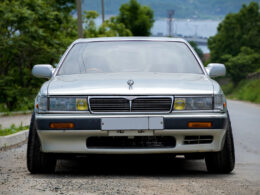Ride height is a bit of an iceberg concept. It seems fairly simple on the surface, but if you dig deeper, you’ll find yourself knee-deep in the suspension dynamics rabbit hole.
Car owners usually care about ride height either for aesthetic reasons or for better lap times. Whether you’re in it for artistic value, practicality, or performance, it’s a fun subject to explore, which is exactly what we’ll do in this article.
Read on as we discuss ride height (RH), how it differs from ground clearance (GC), and its relationship with your car’s center of gravity.
Ride Height Explained

Unlike ground clearance, which measures the distance between the ground and the lowest point on your car’s underbody, ride height has more to do with how far the overall sprung mass of your car sits relative to the ground.
More accurately, ride height refers to the difference between the height of your car’s unsprung mass and sprung mass. The latter includes every component that is supported, lifted, or carried by your suspension system, such as:
- Chassis
- Engine
- Transmission
- Body
- Interior
- Differential (excluding solid axle suspension setups)
- Steering rack
For comparison’s sake, here’s some of what sprung mass does not include (unsprung mass):
- Wheels
- Brake rotors and calipers
- Control arms
- Shocks and struts
- Spindle
Ride height is an excellent comparable yardstick when upgrading your wheels, tires, or suspension, particularly when you’re swapping out your OEM setup for aftermarket coilovers or installing leveling kits.

For instance, if you’re experimenting with different coilovers or lowering springs, ride height is obviously a better metric for comparing before/after results as opposed to ground clearance. This holds true for any upgrade that affects your car’s stance, and much of it relates to how ride we measure ride height.
Even though there’s no standardized technique for measuring ride height, automakers, and aftermarket suspension manufacturers prefer the following methods, with #2 being more popular:
- Measure from the rocker panel to the ground
- Measure from the rim’s center cap to the top of the fender arch
These measurements allow manufacturers to publish information that lets buyers know what changes to expect in ride height after installing their products.
Ride Height vs Ground Clearance
Ground clearance and ride height are similar, but they’re best thought of as separate measurements.

Most of us use these terms interchangeably, which is perfectly alright, but if you get down to the details, you’ll notice some ambiguity surrounding the context in which they’re used as well as objective differences in the way they’re measured.
To reiterate:
- Ride height is the distance between the overall sprung mass of the car (the body, mainly) and the ground, measured from the rim’s center to the top of the fender arch.
- Ground clearance refers to the distance between the lowest part of the car’s undercarriage and the ground.
Ground clearance varies among vehicles as they all have different “low points”; it could be the rocker panel, exhaust, differential, or another undercarriage component.

If we were to look at both ground clearance and ride height as tools and assign them certain functions, they would be:
- GC: Determine what type of obstacles the car or truck can drive over and ascertain approach, departure, and breakover angles.
- RH: Provide a reference point for corner balancing and dialing in fitment after installing aftermarket wheels, tires, suspension, or lift/leveling kits.
Another function that’s intertwined between the two is altering the center of gravity of the vehicle, intentionally or otherwise.
One reason people lower their cars is to drop the center of gravity and improve handling around corners. Conversely, 4×4 owners raise their trucks to clear larger tires, level out the factory rake, and for better clearance on the trails, inadvertently increasing the center of gravity.
That’s why ground clearance is more prevalent in the 4×4 world, while ride height is often associated with lowered street cars. However, clearing obstacles is even more of a pain point for lowered cars, so “ground clearance” isn’t entirely a misnomer in this context.

Ride height is useful for when you’re installing aftermarket components that make your vehicle taller, regardless of their effect on ground clearance or suspension travel. Here are 2 examples:
- Leveling kit: Increases the ride height but doesn’t always change ground clearance. The idea is to install these so you can clear larger tires, which is what will ultimately lift your differential or whatever’s the lowest-hanging component in your case.
- Coilovers: Changes your suspension travel and consequently your ground clearance, with the added benefit of adjustable ride height. This holds true whether you install these for lowering or lifting your vehicle.
Vehicles with solid axle suspension setups experience no change in ground clearance from these upgrades unless they’re equipped with larger tires afterwards. This is because the differential is part of its unsprung mass.
In contrast, vehicles with SLA or wishbone suspension experience a change in both GC and ride height if you alter the suspension travel.
This goes to show that an increase in ground clearance doesn’t necessarily correlate to an increase in ride height and vice versa. Which of the two metrics changes depends on which aftermarket component you’ve installed and the type of your car’s suspension type.
Factors to Consider Before Altering Ride Height

Of all the systems that make our four-wheeled contraptions do what they’re meant to, suspension is arguably the most important since it affects traction and consequently your safety.
A staggering amount of precision goes into the factory suspension design, so if you make invasive alterations like changing the ride height, it’s going to have adverse effects unless they’re accounted for and corrected properly.
Center of Gravity

Aesthetics aside, one of the main reasons why people like lowering their cars is the notion of better handling as a result of lowered center of gravity.
While lowering your car’s ride height will lower its center of gravity, it will also cause other unwanted changes in the suspension geometry, chief among which is a drop in its instant centre and roll centre.
Roll Centre Correction
Roll centre is a theoretical point about which the body of your car rolls when cornering. It can be determined using an intersection of lines drawn from the control arms’ pivots and the wheel’s centerline. The point where the latter intersects the car’s center of gravity is the roll center.
Every car has 2 roll centres and 1 center of gravity — the point at which the entirety of your car’s mass is centralized. In theory, if you suspend your car from this point, it should stay perfectly balanced.

The vertical distance between the roll centre and the center of gravity is the moment arm about which the car’s mass will roll side-to-side, affecting load transfer as a result (also called a roll couple); the shorter this is, the lesser body roll you’ll experience.
When you lower your car, you also end up changing the angle of your control arms. This means in addition to lowering the COG, you also lower the roll center below ground level, which causes even more body roll than you originally had.
You probably won’t feel the excess body roll since lowering your car may have involved switching to stiffer springs, but that energy has to go somewhere. In this case, it ends up going to the tires.
This puts excess load on the tires, causing them to surpass their slip angle during hard cornering. In other words, the tires are forced to do to the heavy lifting while the suspension is underutilized.

You might get away with this when daily driving at the speed limit, but on a track it could be problematic. To fix this, you need to correct your roll center first and foremost, followed by tending to other alignment issues that typically crop up after changing your ride height.
You can do this by installing a roll centre correction kit. For some cars, these are also marketed as bump steer correction kits.
It’s worth mentioning that bump steer usually becomes an issue when you install a roll center correction kit without correcting the resulting change in bump steer. Lowering your car and not installing a roll centre correction kit doesn’t affect bump steer all that much.
So if you’re going to install a RC correction kit, make sure to use its bump steer settings as well. Getting this done at a reputable shop is ideal since they’ll do it for you.
RC correction is just as important for lifted 4x4s. Components like high caster UCAs and driveshaft spacers for IFS trucks and drop pitman arms or drag link flips for solid axle trucks are some of the components that will allow you to do this.
Driveline Angles

Another important factor to consider when you’re altering your ride height, especially if you’re installing a lift kit, is ensuring your pinion angles and CV joints aren’t overextended.
Just like roll center correction, fixing these things after lifting your truck is vital to its reliability. The last thing you want when you’re when you’re out and about is a broken CV axle or driveshaft.
Overextended CV axles are a common cause for concern for lifted trucks with independent suspension while driveshaft extension is more prevalent among solid axle setups.
For solid axle rigs, you might notice an overextension between the driveshaft and transfer case depending on how much you lift you add. This can be remedied with the help of transfer case spacers, replacement u-bolts, or double cardan heads, to name a few.

Unlike solid axle setups where the steering and outer joint angles don’t change much after lifting, trucks with independent suspensions are very limited in how much angle the CV joints can tolerate.
Relocating the diff and suspension pick-up points is one solution. It may also involve using subframe spacers, pinion angle correction shims, aftermarket frame cross members, taller knuckles, and adjustable control arms.
The more you lift, the more components you’re going to need to offset any unwanted changes in the driveline angles and suspension geometry.
Get Low

Behind each production car is a team of engineers who’s job is to obsess over every square inch of its design. Naturally, changing important aspects of said design will lead to unwanted chain reactions.
However, automakers require their mass produced cars to appeal to a wider audience. Amidst the conundrum of emissions norms, road safety protocol, pricing, and profits, engineers are required to follow strict design requirements; some less desirable than others.
There’s definitely room for improvement, as long it’s done properly. What you want is a bespoke configuration carefully designed for your needs, not heavily compromised utility in the name of aesthetics, unless that’s the goal from the get go.
Whether you seek a functional drop in ride height or want to lay frame because you like the looks of it, our only advise is to be mindful of the changes you’re making.
Got any insights you’d like to share with us? Feel free to leave a comment below!










